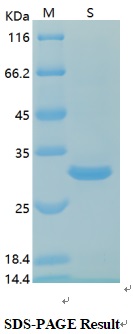Product Name :
CD1B Recombinant Protein Swiss-Prot :
P29016 Host :
E.coli Tag :
≥0.5mg/ml Amino acid Sequence :
SEHAFQGPTSFHVIQTSSFTNSTWAQTQGSGWLDDLQIHGWDSDSGTAIFLKPWSKGNFSDKEVAELEEIFRVYIFGFAREVQDFAGDFQMKYPFEIQGIAGCELHSGGAIVSFLRGALGGLDFLSVKNASCVPSPEGGSRAQKFCALIIQYQGIMETVRILLYETCPRYLLGVLNAGKADLQRQVKPEAWLSSGPSPGPGRLQLVCHVSGFYPKPVWVMWMRGEQEQQGTQLGDILPNANWTWYLRATLDVADGEAAGLSCRVKHSSLEGQDIILYWRNPTSIGS Restriction sites :
NdeI-XhoI Background :
The CD1 multigene family encodes five forms of the CD1 T cell surface glycoprotein in human, designated CD1A, 1B, 1C, 1D and 1E. CD1, a type 1 membrane protein, has structural similarity to the MHC class I antigen and has been shown to present lipid antigens for recognition by T lymphocytes. CD1 antigens are associated with β-2-Microglobulin and expressed on cortical thymocytes, Langerhans cells, a B cell subset and some dendritic cells. Specifically, CD1A is a marker for Langerhans cell histiocytosis (LCH) and is found on interdigitating cells. Adaptor-protein complexes and CD1-associated chaperones control CD1 trafficking, and the development and activation of CD1-restricted T cells. Constitutive endocytosis of CD1B molecules and the differential sorting of MHC class II from lysosomes separate peptide- and lipid antigen-presenting molecules during dendritic cell maturation. CD1B is also expressed in interdigitating cells. The human CD1 genes are all closely linked in a cluster mapping at chromosome 1q 23.1. Soluble :
PBS, 4M Urea, PH7.4 Purification&Purity :
Transferred into competent cells and the supernatant was purified by NI column affinity chromatography and the purity is > 85% (by SDS-PAGE). Storage&Stability :
Store at 4°C short term. Aliquot and store at -20°C long term. Avoid freeze-thaw cycles. Expression vector :
pet-22b(+) BiowMW :
~32kDa Note :
For research use only, not for use in diagnostic procedure. concentration :
≥0.5mg/ml
CD1B Recombinant Protein Swiss-Prot :
P29016 Host :
E.coli Tag :
≥0.5mg/ml Amino acid Sequence :
SEHAFQGPTSFHVIQTSSFTNSTWAQTQGSGWLDDLQIHGWDSDSGTAIFLKPWSKGNFSDKEVAELEEIFRVYIFGFAREVQDFAGDFQMKYPFEIQGIAGCELHSGGAIVSFLRGALGGLDFLSVKNASCVPSPEGGSRAQKFCALIIQYQGIMETVRILLYETCPRYLLGVLNAGKADLQRQVKPEAWLSSGPSPGPGRLQLVCHVSGFYPKPVWVMWMRGEQEQQGTQLGDILPNANWTWYLRATLDVADGEAAGLSCRVKHSSLEGQDIILYWRNPTSIGS Restriction sites :
NdeI-XhoI Background :
The CD1 multigene family encodes five forms of the CD1 T cell surface glycoprotein in human, designated CD1A, 1B, 1C, 1D and 1E. CD1, a type 1 membrane protein, has structural similarity to the MHC class I antigen and has been shown to present lipid antigens for recognition by T lymphocytes. CD1 antigens are associated with β-2-Microglobulin and expressed on cortical thymocytes, Langerhans cells, a B cell subset and some dendritic cells. Specifically, CD1A is a marker for Langerhans cell histiocytosis (LCH) and is found on interdigitating cells. Adaptor-protein complexes and CD1-associated chaperones control CD1 trafficking, and the development and activation of CD1-restricted T cells. Constitutive endocytosis of CD1B molecules and the differential sorting of MHC class II from lysosomes separate peptide- and lipid antigen-presenting molecules during dendritic cell maturation. CD1B is also expressed in interdigitating cells. The human CD1 genes are all closely linked in a cluster mapping at chromosome 1q 23.1. Soluble :
PBS, 4M Urea, PH7.4 Purification&Purity :
Transferred into competent cells and the supernatant was purified by NI column affinity chromatography and the purity is > 85% (by SDS-PAGE). Storage&Stability :
Store at 4°C short term. Aliquot and store at -20°C long term. Avoid freeze-thaw cycles. Expression vector :
pet-22b(+) BiowMW :
~32kDa Note :
For research use only, not for use in diagnostic procedure. concentration :
≥0.5mg/ml
Blocking peptide available as NCP0186P

 CD1B Recombinant Protein
CD1B Recombinant Protein 
 Datasheet
Datasheet COA
COA MSDS
MSDS SHIP
SHIP